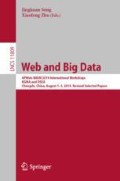Abstract
Re-identification is a challenging task because the available information is partial. This paper presents an approach to tackle vehicle re-identification (Re-id) problem. We focus on pose estimation for vehicles, which is an important module of vehicle Re-id. Person Re-id received huge attention, while vehicle re-id was ignored, but recently the computer vision community have started focusing on this topic and have tried to solve this problem by only using spatiotemporal information while neglecting the driving direction. The proposed technique is using visual features to find poses of the vehicle which helps to find driving directions. Experiments are conducted on publicly available datasets VeRi and CompCars, the proposed approach got excellent results.
Access this chapter
Tax calculation will be finalised at checkout
Purchases are for personal use only
References
Zhang, Y., Bai, Y., Ding, M., Li, Y., Ghanem, B.: W2f: a weakly-supervised to fully-supervised framework for object detection. In: The IEEE Conference on Computer Vision and Pattern Recognition (CVPR), June 2018
Mahendran, S., Vidal, R.: Car segmentation and pose estimation using 3d object models (2015)
Liu, H., Tian, Y., Yang, Y., Pang, L., Huang, T.: Deep relative distance learning: tell the difference between similar vehicles. In: The IEEE Conference on Computer Vision and Pattern Recognition (CVPR), June 2016
Ahmed, M.J., Sarfraz, M., Zidouri, A., Al-Khatib, W.G.: License plate recognition system. In: 10th IEEE International Conference on Electronics, Circuits and Systems, 2003. ICECS 2003. Proceedings of the 2003, vol. 2, pp. 898–901 (2003)
Bulan, O., Kozitsky, V., Ramesh, P., Shreve, M.: Segmentation- and annotation-free license plate recognition with deep localization and failure identification. IEEE Trans. Intell. Transp. Syst. 18(9), 2351–2363 (2017)
Anagnostopoulos, C.N.E., Anagnostopoulos, I.E., Loumos, V., Kayafas, E.: A license plate-recognition algorithm for intelligent transportation system applications. IEEE Trans. Intell. Transp. Syst. 7(3), 377–392 (2006)
Ahmed, E., Jones, M., Marks, T.K.: An improved deep learning architecture for person re-identification. In: The IEEE Conference on Computer Vision and Pattern Recognition (CVPR), June 2015
Xiao, T., Li, H., Ouyang, W., Wang, X.: Learning deep feature representations with domain guided dropout for person re-identification. In: The IEEE Conference on Computer Vision and Pattern Recognition (CVPR), June 2016
Liu, X., Liu, W., Ma, H., Fu, H.: Large-scale vehicle re-identification in urban surveillance videos. In: 2016 IEEE International Conference on Multimedia and Expo (ICME), pp. 1–6, July 2016
Yang, L., Luo, P., Loy, C.C., Tang, X.: A large-scale car dataset for fine-grained categorization and verification. In: 2015 IEEE Conference on Computer Vision and Pattern Recognition (CVPR), pp. 3973–3981, June 2015
Sun, Y., Wang, X., Tang, X.: Deep learning face representation from predicting 10,000 classes. In: The IEEE Conference on Computer Vision and Pattern Recognition (CVPR), June 2014
Sun, Y., Chen, Y., Wang, X., Tang, X.: Deep learning face representation by joint identification-verification. In: Ghahramani, Z., Welling, M., Cortes, C., Lawrence, N.D., Weinberger, K.Q. (eds.) Advances in Neural Information Processing Systems 27, pp. 1988–1996. Curran Associates, Inc. (2014)
Sun, Y., Liang, D., Wang, X., Tang, X.: Deepid3: Face recognition with very deep neural networks (2015)
Wen, Y., Zhang, K., Li, Z., Qiao, Y.: A discriminative feature learning approach for deep face recognition. In: Leibe, B., Matas, J., Sebe, N., Welling, M. (eds.) ECCV 2016. LNCS, vol. 9911, pp. 499–515. Springer, Cham (2016). https://doi.org/10.1007/978-3-319-46478-7_31
Taigman, Y., Yang, M., Ranzato, M., Wolf, L.: Deepface: Closing the gap to human-level performance in face verification. In: The IEEE Conference on Computer Vision and Pattern Recognition (CVPR), June 2014
Liao, S., Hu, Y., Zhu, X., Li, S.Z.: Person re-identification by local maximal occurrence representation and metric learning. In: The IEEE Conference on Computer Vision and Pattern Recognition (CVPR), June 2015
Liao, S., Hu, Y., Li, S.Z.: Joint dimension reduction and metric learning for person re-identification. arXiv preprint arXiv:1406.4216 (2014)
Feris, R.S., et al.: Large-scale vehicle detection, indexing, and search in urban surveillance videos. IEEE Trans. Multimedia 14(1), 28–42 (2012)
Matei, B.C., Sawhney, H.S., Samarasekera, S.: Vehicle tracking across nonoverlapping cameras using joint kinematic and appearance features. CVPR 2011, 3465–3472 (2011)
Liu, X., Zhang, S., Huang, Q., Gao, W.: Ram: a region-aware deep model for vehicle re-identification. In: 2018 IEEE International Conference on Multimedia and Expo (ICME), pp. 1–6, July 2018
Liu, X., Liu, W., Mei, T., Ma, H.: Provid: progressive and multimodal vehicle reidentification for large-scale urban surveillance. IEEE Trans. Multimedia 20(3), 645–658 (2018)
Khare, V., et al.: A novel character segmentation-reconstruction approach for license plate recognition. Expert Syst. Appl. 131, 219–239 (2019)
Hendry, Chen, R.C.: Automatic license plate recognition via sliding-window darknet-yolo deep learning. Image Vis. Comput. 87, 47–56 (2019)
Szegedy, C., Vanhoucke, V., Ioffe, S., Shlens, J., Wojna, Z.: Rethinking the inception architecture for computer vision. In: The IEEE Conference on Computer Vision and Pattern Recognition (CVPR), June 2016
He, K., Zhang, X., Ren, S., Sun, J.: Deep residual learning for image recognition. In: The IEEE Conference on Computer Vision and Pattern Recognition (CVPR), June 2016
Ding, S., Lin, L., Wang, G., Chao, H.: Deep feature learning with relative distance comparison for person re-identification. Pattern Recogn. 48(10), 2993–3003 (2015)
Author information
Authors and Affiliations
Corresponding author
Editor information
Editors and Affiliations
Rights and permissions
Copyright information
© 2019 Springer Nature Switzerland AG
About this paper
Cite this paper
Tumrani, S., Deng, Z., Khan, A.A., Ali, W. (2019). PEVR: Pose Estimation for Vehicle Re-Identification. In: Song, J., Zhu, X. (eds) Web and Big Data. APWeb-WAIM 2019. Lecture Notes in Computer Science(), vol 11809. Springer, Cham. https://doi.org/10.1007/978-3-030-33982-1_6
Download citation
DOI: https://doi.org/10.1007/978-3-030-33982-1_6
Published:
Publisher Name: Springer, Cham
Print ISBN: 978-3-030-33981-4
Online ISBN: 978-3-030-33982-1
eBook Packages: Computer ScienceComputer Science (R0)

